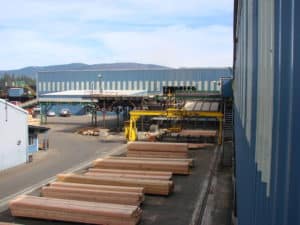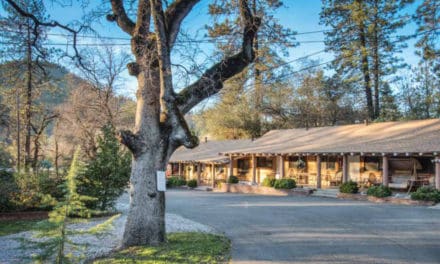Anyone who has stood in the soft light beneath a stand of towering pines can appreciate the absolute beauty of our forests – their value is beyond measure. Home to a variety of plants and wildlife, they also provide us with a multitude of recreational adventure. For the people who live in the small towns dotting the Sierra landscape, the forest can also represent opportunities for jobs and a strong economy. Keeping our precious forests healthy and safe is vital to all of us.
Contemporary timber harvesting can be an important tool in maintaining healthy forests. With advanced technology and modern forestry techniques, logging is now done with protection of the environment as a top priority. Implementing good management, timber companies can “mimic natural forest events” and help to reduce the threat of catastrophic wildfires.
Although fires can be a natural occurrence, we have all seen the devastation of massive fires in recent years. Not only do catastrophic fires destroy trees, homes and wildlife habitat, they release immense amounts of carbon into the air and damage the soil. Many forests have become too thick and crowded – making them susceptible to intense fires and harder to defend, once burning. Firefighters do an amazing job of fire management and work hard to minimize damage, but timber companies can help by thinning trees, clearing brush and creating fuel breaks.
Sierra Pacific Industries (SPI) is a forest products company that has fully embraced its role in working to ensure that our forests remain vibrant for the future. The third generation, family-owned company is based in Northern California and was started in 1949 by A.A. (Red) Emmerson and his father R.H. (Curly) Emmerson. They are currently one of the largest lumber producers in the United States.
SPI states on their website that “the company owns and manages nearly 1.9 million acres of timberland in California and Washington.” It goes on to say, “SPI is committed to managing its lands in a responsible and sustainable manner to protect the environment while providing quality wood products and renewable power for consumers.” These statements are supported by a great deal of research and information listed at www.spi-ind.com.
According to Mark Lathrop, spokesperson for SPI, in addition to following strict state and federal regulations, the company is certified by the Sustainable Forestry Initiative (SFI) where they undergo rigorous research by an independent third party.
Mark explained that SPI employs professional foresters, wildlife biologists, botanists and other natural resource specialists to ensure that wildlife habitat, water quality and the environment are protected. He stated that they have over eighty professional foresters in California who are experts in proper forest management.
“Not only do our foresters have a four year college degree, they need to pass a tough exam, which currently has only about a twenty-five percent passing rate. They also must first work for three years under another registered, professional forester. They really have to know their stuff,” Mark said.
He added that SPI has collected seeds off their land to create a seed bank that “regeneration foresters” use to re-supply forestland after timber harvesting or a fire, “with trees from that zone, elevation and latitude.” SPI plants between five and ten million new trees per year.
“Overall, we don’t harvest more wood than we grow in our forests,” Mark said.
Apparently thinning trees and brush does more than just reduce fire danger and create fuel breaks. The open sunlight is necessary for the seedlings of some species of trees to thrive. Mark added, “Although, even in cleared areas, we leave habitat retention zones, which are used by wildlife and become old growth as the new forest grows up around them.”
Young forests contribute a surprising benefit to the environment, with their role in the “carbon cycle.” According to the SPI website, “Fast growing, healthy trees store more carbon than an over-mature forest. As a tree grows, it stores carbon in its trunk, branches and roots and produces the oxygen that we need.”
As far as SPI sawmills are concerned, they too are keeping up with modern methods. The company has fourteen sawmills in California and Washington that use “state-of-the-art computer technology” to ensure that they get the most out of their timber resources.
After many renovations over the years, the large-log mill in Quincy was recently rebuilt. The old sawmill was taken down in 2014, with construction of a new one completed in 2015. Quincy also has a small-log mill, planer, dry kilns, two cogeneration plants and a small railway line. The facility employs over 300 people, which helps to keep the local economy viable.
According to Chris Skinner, SPI manager of the Quincy division, the new mill uses a proven design that is more efficient. “Using computers and scanners, skilled operators use technology to make decisions of how to get the most lumber out of a log,” he said. “We maintain one-hundred percent utilization of logs that come into the mill. We want to recover as much fiber in lumber, but make use of all by-products such as bark, shavings and hog-wood.”
Chris explained that decades ago the hog-wood was a waste product and now they use it to generate electricity in a biomass-fueled electric power plant, called a Cogen or cogeneration plant.
“We burn the hog fuel in a very controlled environment with continuous emission monitoring systems. It’s very clean and a renewable resource. The amount fluctuates but we can generate about twenty-five megawatts per hour,” Chris said. “We use about six to seven megawatts to run the plant and sell any excess power to electric companies. One megawatt equals enough electricity to power approximately one thousand homes.”
In addition to being more efficient, Chris stated that the new mill allows them to produce lumber up to twenty-eight feet in length and timbers for building materials.

It’s interesting to note that SPI is one of the largest “pencil stock” producers in the world. Just as the name implies, it is used to manufacture pencils for writing and drawing. Quincy is one of the mills that makes “pencil stock,” which is usually 3 x 3 inch or 3 x 6 inch pieces of Incense Cedar that can be up to twenty feet long.
“Lumber is shipped out on trucks, but we prefer to ship by railroad,” Chris said. “A rail-car can hold about four truck loads of lumber.”
Not only is SPI committed to the health of the forest and the economies of local towns, they are dedicated to supporting youth programs and education. According to Mark Lathrop, the Sierra Pacific Foundation awards scholarships to the children of employees and sponsors sport groups, 4-H and FFA programs.
Chris added, “We donate shavings for bedding at the fairs and purchase project animals to support the kids.”
“SPI also offers mill and forest tours to agriculture and forestry students, as well as school children,” Mark said.
With all the advancements that Sierra Pacific Industries has made with their commitment to the environment, perhaps young people can gain a better understanding of how modern forestry works. With that knowledge, hopefully they can continue to develop better solutions to keep forests healthy and rural towns thriving for generations to come.












